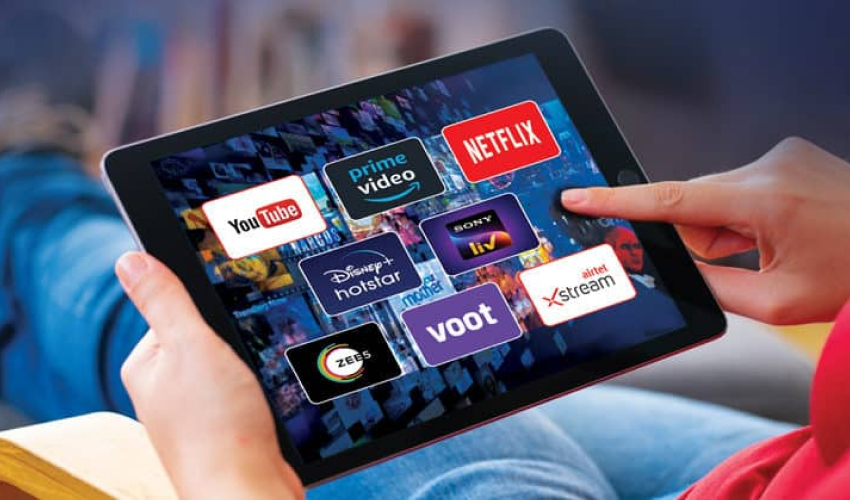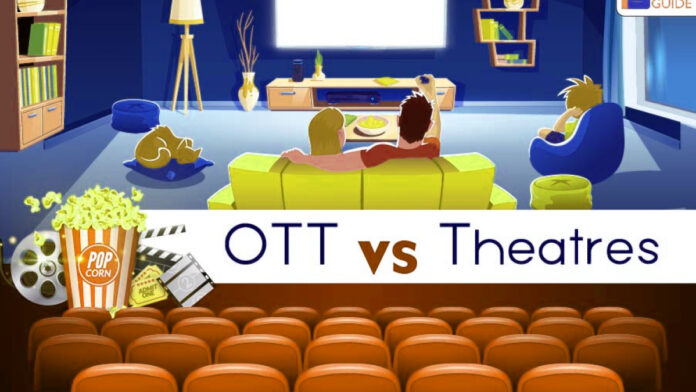The entertainment industry has seen a significant shift in how people consume movies in recent years. Traditional movie theaters face stiff competition with the rise of Over-the-top (OTT) platforms like Netflix, Amazon Prime Video, and Disney+. While theaters have been the go-to place for movie enthusiasts for decades, OTT Platforms Vs Theaters have disrupted the industry by offering a more convenient, affordable, and personalized movie viewing experience.
This has led to a debate on whether OTT platforms will eventually replace theaters as the future of movies or if they will coexist as complementary options for different moviegoers.
In this context, it’s worth exploring OTT vs. theater pros and cons to analyze their impact on the film industry to understand the potential future of movies. In this blog, we go through OTT Platforms Vs. Theater: Which one is the future of film?
What are OTT Platforms and Streaming apps?
Over-the-top (OTT) platforms and streaming apps have revolutionized how people watch movies, TV shows, and other digital content.
These platforms allow viewers to stream media content directly over the internet, bypassing traditional distribution channels like cable TV or movie theaters.
OTT platforms and streaming apps have become increasingly favored due to their comfort, low cost, and availability.
OTT platforms are services that offer on-demand video streaming over the internet. Popular OTT platforms include Netflix, Amazon Prime Video, Disney+, Hulu, and HBO Max.
These platforms offer various movies, TV shows, documentaries, and other original content that can be watched on-demand on smartphones, tablets, laptops, and smart TVs.
Some OTT platforms also offer live streaming of sports events and other live programming.
On the other hand, streaming apps allow users to stream media content on their mobile devices like smartphones and tablets. Examples of popular streaming apps include YouTube, TikTok, and Instagram.
These apps allow users to watch short-form videos, user-generated content, and live streaming of events on their mobile devices.
One of the critical advantages of OTT platforms and streaming apps is their flexibility and convenience. Subscribers can eye their favored films, TV presentations, and other content at their own pace and schedule.
These platforms offer a more personalized viewing experience, allowing users to customize their viewing preferences and discover new content based on their interests.
Overall, the rise of OTT platforms and streaming apps has disrupted the traditional media distribution model and has opened up new opportunities for content creators and distributors to reach audiences directly.
With the continued growth of internet connectivity and mobile devices, the popularity of these platforms will likely continue to grow in the coming years.
How are OTT Platforms growing in India?
Over-the-top (OTT) platforms are experiencing significant growth in India due to various factors such as affordable internet connectivity, rising smartphone usage, and a young and tech-savvy population.
According to a report by KPMG, the Indian OTT market is expected to reach a value of $5 billion by the end of 2023, up from $1.5 billion in 2018.
One of the main drivers of OTT growth in India is the increasing adoption of affordable mobile data plans. The launch of Reliance Jio in 2016, a telecom provider that offered low-cost data plans, resulted in a massive surge in internet users in India. This has increased digital content consumption on OTT platforms, particularly among younger audiences.
The pandemic-induced lockdowns also played a significant role in boosting the growth of OTT platforms in India. With theaters closed, consumers turned to OTT platforms for entertainment, increasing subscriptions and viewership.
According to a report by Redseer, the Indian OTT industry grew by 30% in 2020, with the total number of paid subscribers reaching 53 million.
Also See: How Does The OTT Platforms Work and Make Money
The availability of regional language content is another component impacting the expansion of OTT platforms in the vast country. These platforms have invested in creating original content in regional languages, catering to the diverse linguistic and cultural preferences of Indian audiences. This has helped to increase their user base in smaller towns and cities where restricted language content is more popular.
Overall, the Indian OTT demand is anticipated to expand in the forthcoming years, with increased investment in original content, expansion into new markets, and the launch of more affordable subscription plans.
However, the market is also becoming increasingly competitive, with regional and global participants competing for a more significant market stake. This competition will likely increase innovation and better content offerings for Indian viewers.
OTT vs. Theaters: Pros and Cons
The rise of Over-the-top (OTT) platforms has disrupted the traditional movie distribution model, challenging the dominance of movie theaters. While theaters have long been the go-to place for movie enthusiasts, OTT platforms offer a more convenient, affordable, and personalized movie viewing experience. However, both formats have unique challenges and benefits, so we go through the OTT Vs theater pros and cons.
Challenges of OTT platforms:

- Internet Connectivity: The biggest challenge of OTT platforms is the need for a stable and fast internet connection. In countries with unreliable internet connectivity, accessing streaming services can be challenging.
- Content discovery: With so much content available on OTT platforms, it can be challenging for users to discover new content. Platforms rely on algorithms to recommend content to users, which can result in a lack of diversity and uncertainty.
- Content Quality: OTT platforms have been criticized for the quality of their content, particularly original programming. While some platforms have invested in high-quality original content, others have been accused of producing low-budget, formulaic shows and movies.
Challenges of Movie Theaters:

- Cost: Movie theaters are often more expensive than OTT platforms, particularly for families or groups. The price of tickets, concessions, and conveyance can count up quickly, causing movie-going a costly experience.
- Accessibility: Movie theaters are not accessible to everyone. Individuals with handicaps, those staying in distant places, or those without transportation may find it challenging to access theaters.
- Scheduling: Theaters have set schedules, meaning viewers must plan their movie-watching around the theater’s showtimes. This can be challenging for people with busy schedules or those who want to watch movies at their own pace.
Benefits of OTT platforms:
- Convenience: OTT platforms offer a more convenient movie-watching experience. Viewers can watch movies on-demand, on their schedule, and on various devices.
- Variety: OTT platforms offer a wide variety of content, including classic movies, foreign-language films, and original programming, catering to diverse tastes and interests.
- Personalization: OTT platforms offer a personalized viewing experience, with tailored recommendations based on the viewer’s viewing history and preferences.
Benefits of Movie Theaters:
- Immersive Experience: Movie theaters offer an immersive movie-watching experience with high-quality sound and projection and the ability to watch movies on a big screen.
- Social experience: Movie theaters provide a social experience, allowing friends and family to gather to watch movies.
- Event movies: Movie theaters are the go-to place for event movies, like blockbuster releases or awards season favorites, providing a unique communal experience.
Overall, both OTT platforms and theaters have their unique challenges and benefits. While OTT platforms have disrupted the traditional movie distribution model, theaters continue to provide a unique and immersive movie-watching experience. The future of movies will likely involve a combination of both formats, catering to different types of moviegoers.
OTT Platforms Vs. Theatres- USPs
Over-the-top (OTT) platforms and movie theaters offer unique selling points (USPs) catering to different movie-watching experiences.
Here are a few of the USPs of OTT platforms and theaters:
USPs of OTT platforms:
- Convenience: One of the main USPs of OTT platforms is convenience. Viewers can watch movies and shows whenever they like, anyplace, and on any gadget with a net link.
- Cost-effective: OTT platforms offer a cost-effective way to watch movies and shows, particularly for those who consume a lot of content. With a subscription, viewers can access a vast library of movies and shows for a fraction of the cost of going to a theater.
- Personalization: OTT platforms use algorithms and viewer data to offer personalized recommendations and a tailored viewing experience. This can help viewers discover new content that matches their interests and preferences.
- Original Content: OTT platforms invest heavily in original content, allowing them to create unique and diverse programming that may not be available on traditional TV networks or in theaters.
USPs of Theaters:
- Immersive Experience: Theaters offer an immersive movie-watching experience with high-quality sound and projection and the ability to watch movies on a big screen. This can enhance the overall viewing experience and make it more impactful.
- Social Experience: Going to a theater is a social experience that allows viewers to watch movies with friends and family. This can create a shared understanding and memories that viewers can cherish.
- Event Movies: Theaters are the go-to place for event movies, like blockbuster releases or awards season favorites. These movies are often designed for the big screen; watching them in a theater can provide a unique communal experience.
- Snacks: Movie theaters are famous for their snack offerings, which include popcorn, candy, and soda. These snacks can add to the movie-going event and make it pleasing.
Both OTT platforms and theaters have unique selling points catering to different movie-watching experiences. While OTT platforms offer convenience and cost-effectiveness, theaters provide an immersive and social background, particularly for event movies. The choice between OTT platforms vs. theaters ultimately depends on the viewer’s preferences and priorities.
Future of OTT Platforms and Movie Streaming Apps in India
The future of Over-the-top (OTT) platforms and movie streaming apps in India looks bright as more and more consumers turn to these services for entertainment. With a growing population, increasing internet penetration, and strong demand for affordable and convenient entertainment options, the Indian market presents a significant growth opportunity for OTT platforms and streaming apps.
Here are some of the trends that are shaping the future of OTT platforms and movie-streaming apps in India:
- Regional content: India is a manifold land with multiple vocabularies and civilizations, and viewers strongly prefer restricted content. OTT platforms are increasingly investing in regional content, catering to viewers in different parts of the country. This trend will likely continue, with more platforms focusing on regional programming to attract a broader audience.
- Original content: Original content is becoming increasingly popular in India as viewers seek new and unique programming. OTT platforms invest heavily in creating original content catering to local tastes and preferences. This trend will likely continue, with more platforms launching their original programming.
- Mobile-first approach: India has one of the largest smartphone markets in the world, and mobile devices are the primary mode of internet access for many Indians. OTT platforms are adopting a mobile-first approach, with mobile apps that offer a seamless viewing experience on smartphones and tablets. This trend will likely continue, with more platforms focusing on mobile devices as the primary content consumption mode.
- Affordable pricing: Price sensitivity is a significant factor in India, and viewers are unwilling to pay high prices for content. OTT platforms and movie streaming apps offer affordable pricing plans, catering to viewers of different budgets. This trend will likely continue, with more platforms launching low-cost subscription plans to attract price-sensitive viewers.
- Partnerships and collaborations: OTT platforms and movie streaming apps are partnering with telecom operators, content producers, and other players in the ecosystem to offer a seamless and integrated viewing experience. This trend is likely to continue, with more collaborations and partnerships that provide value to consumers.
The future of OTT platforms and movie streaming apps in India looks promising, with a growing market, increasing internet penetration, and a strong demand for affordable and convenient entertainment options. The trends of regional content, original content, mobile-first approach, affordable pricing, and partnerships will likely shape the future of these services in India.
Future of Movie Theaters in India
The future of movie theaters in India is a subject of much debate, as the rise of Over-the-top (OTT) platforms and movie streaming apps has led to a decline in theater attendance. However, despite these challenges, movie theaters will likely remain an essential part of India’s entertainment ecosystem, with several factors indicating a promising future for this industry.
Here are a few of the aspects that are likely to shape the future of movie theaters in India:
- Infrastructure development: India is undergoing significant infrastructure development, with new malls and multiplexes opening up in cities and towns nationwide. This trend is likely to continue, with more investments in cinema infrastructure that provides viewers with a comfortable and immersive viewing experience.
- Event movies: Event movies, like big-budget blockbusters, are designed for the big screen, and the theater experience is an essential part of the viewing experience. Movie theaters will continue to play a critical role in releasing and promoting event movies, with viewers flocking to cinemas to watch these movies on the big screen.
- Rural markets: While urban markets have seen a decline in theater attendance, rural markets present a significant opportunity for movie theaters. With increasing disposable incomes and growing access to entertainment options, rural viewers will likely become an essential demographic for the movie theater industry.
- Premium experiences: Movie theaters increasingly offer premium experiences, such as 3D and 4D screenings, luxury seating, and gourmet food and beverage options. These premium experiences cater to viewers willing to pay a premium for an immersive and personalized movie-watching experience.
- Government support: The Indian administration has realized the importance of the movie theater industry and has taken measures to help its development. Initiatives like the National Film Heritage Mission and the Film Facilitation Office promote the development of the Indian film industry, including movie theaters.
The future of movie theaters in India looks promising, with infrastructure development, event movies, rural markets, premium experiences, and government support indicating a positive outlook for this industry. While the rise of OTT platforms and movie streaming apps has led to a decline in theater attendance, movie theaters will continue to play a critical role in the Indian entertainment ecosystem, providing viewers with a unique and immersive movie-watching experience.
Conclusion
the future of entertainment in India will likely combine OTT platforms and movie theaters. While OTT platforms and movie streaming apps have disrupted the traditional movie-watching experience and continue to gain popularity, multiplexes offer a memorable and mesmerizing occurrence that cannot be recited at your place.
As technology evolves and consumer preferences shift, OTT platforms and movie theaters must adapt and innovate to stay relevant. The key to success for both will be to focus on delivering high-quality content and experiences that cater to the diverse needs and preferences of Indian viewers.
Overall, the competition between the OTT platform vs. theaters is a healthy development for the entertainment industry, driving innovation and offering consumers more choices and convenience. Whether you prefer the comfort and convenience of watching movies at home or the unique experience of watching a film on the big screen, the future of entertainment in India offers something for everyone. We hope this blog on OTT Platforms Vs. Theaters: Which one is the future of movies is useful to the readers


